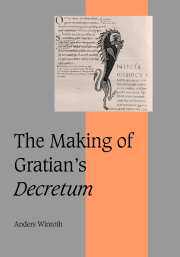Book contents
- Frontmatter
- Contents
- List of illustrations
- List of tables
- Preface
- List of abbreviations and Conspectus siglorum
- 1 GRATIAN AND THE DECRETUM
- 2 HERESY AND EXCOMMUNICATION: CAUSA 24
- 3 OBEDIENCE OR CONTEMPT: CAUSA 11, QUESTIO 3
- 4 THE TWO RECENSIONS OF THE DECRETUM
- 5 GRATIAN AND ROMAN LAW
- 6 THE MEN BEHIND THE DECRETUM
- CONCLUSION: MEDIEVAL LAW AND THE DECRETUM
- Appendix: The contents of the first recension of Gratian's Decretum
- Bibliography
- Index of cited passages in Gratian's Decretum
- Index of papal letters
- General index
- Cambridge Studies in Medieval Life and Thought Fourth series
5 - GRATIAN AND ROMAN LAW
Published online by Cambridge University Press: 11 September 2009
- Frontmatter
- Contents
- List of illustrations
- List of tables
- Preface
- List of abbreviations and Conspectus siglorum
- 1 GRATIAN AND THE DECRETUM
- 2 HERESY AND EXCOMMUNICATION: CAUSA 24
- 3 OBEDIENCE OR CONTEMPT: CAUSA 11, QUESTIO 3
- 4 THE TWO RECENSIONS OF THE DECRETUM
- 5 GRATIAN AND ROMAN LAW
- 6 THE MEN BEHIND THE DECRETUM
- CONCLUSION: MEDIEVAL LAW AND THE DECRETUM
- Appendix: The contents of the first recension of Gratian's Decretum
- Bibliography
- Index of cited passages in Gratian's Decretum
- Index of papal letters
- General index
- Cambridge Studies in Medieval Life and Thought Fourth series
Summary
Gratian's use of Roman law has been much discussed in modern scholarship. The debate began in 1947 when Adam Vetulani argued that most texts in the Decretum deriving from Justinianic Roman law had been added after the completion of Gratian's work. Only those romanistic texts that were available in earlier canonical collections would have been included in Gratian's original work. These conclusions were quickly accepted. In 1953, Stephan Kuttner retraced and expanded Vetulani's arguments and identified forty-six passages in the Decretum as late additions to the text. His list was, with one or two exceptions, identical to Vetulani's.
This book confirms the general thrust of their work. All but three of the forty-six passages are absent from the first recension. One of the three exceptions is C. 2, q. 6, c. 28, which is the only Novel that the Decretum quotes directly from the Authenticum, rather than from the authenticae of Justinian's Code. Vetulani suggested that this text was taken from some hypothetical intermediate collection, implying that it was part of Gratian's original composition. Kuttner was not convinced by this reasoning; he included the text in his list of additions to the Decretum. The presence of this text in the first recension indicates that Vetulani was right.
- Type
- Chapter
- Information
- The Making of Gratian's Decretum , pp. 146 - 174Publisher: Cambridge University PressPrint publication year: 2000

